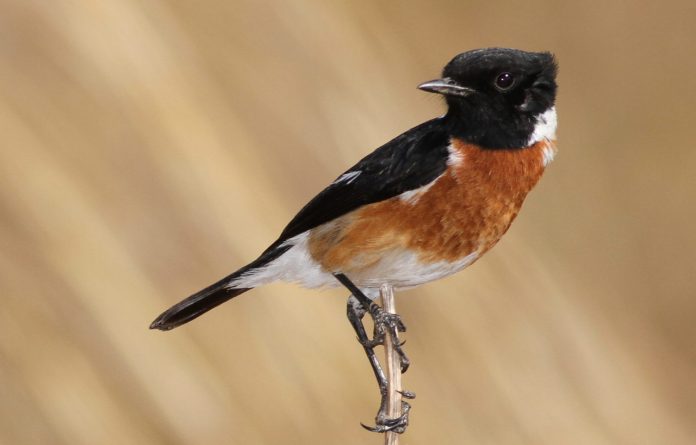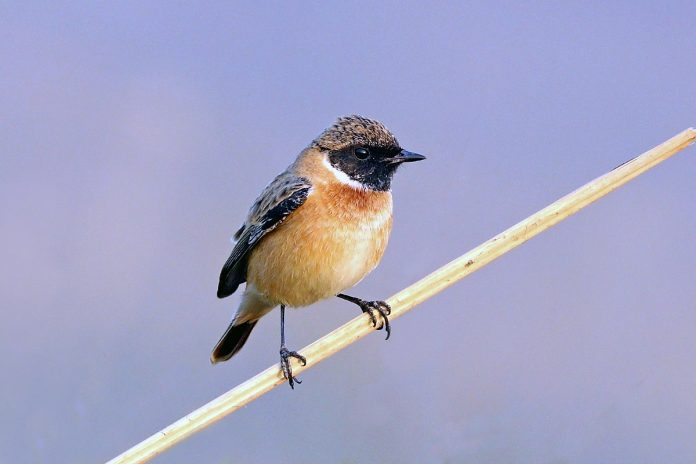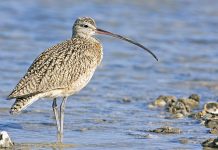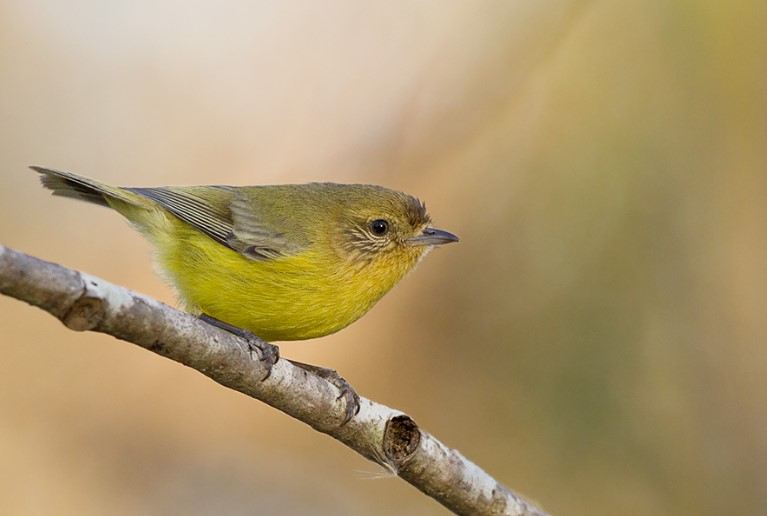Habitat: Common stonechat is found in an open bushy country of all types, from mountainsides, moorland, and steppe to coastal cliffs and islands. Outside the breeding season, it is also about cultivation.
Common Stonechat; African Stonechat (S. t. maura, etc.) is a medium-sized bird of 12.5 cm in length. A conspicuous small chat of open country with scattered bushes Common Stonechat normally perches upright on prominent bush tops or wires, flicking wings and tails, usually solitary or at family parties.
Identification: Common Stonechat (Saxicola torquata) adult males of all races have both throat and head that are black or blackish, along with a white neck and’scapular’ patches (latter actually inner wing coverts and more often than not concealed when at rest), an orange breast, pale rump-upper tail coverts, and (except Caspian-Transcaucasian races) an all-dark tail. It is much brighter, most obvious in spring when the plumage is worn; in fresh plumage, both color and pattern are fairly obscured by brownish or buffish feather tips.
Moreover, the racial variation is perplexing, and for field-identification reasons, it is best separated into three groups of races. Western races are “rubicola and hibernans”. Males as above, with orange on underparts habitually quite extensive, particularly in darker Hibernians (W Europe), but when worn (i.e., in spring), can be extremely pale below, and rump patches come into view whitish (buff when fresh), particularly so in southern populations, although pale rump patches are narrower than in eastern forms.
Common Stonechat females typically have a dusky or mottled throat, and the supercilium is lacking or very indistinct, although there is some individual variation, with some females having an almost pale grayish-buff on the throat (but more rufous below and darker above than the W Siberian race); the rump patch is similarly variable, but always with some weak streaking. The confusion is with other members of the genus, which is unlikely.
When compared with Whinchat and highly localized Canary Islands Stonechat, the West Siberian race “Maura” is modestly smaller and somewhat longer-winged than western races. The adult male has a clear, whitish rump patch, naturally streaked in western forms. Even if the rump patch looks very pale, the blacker underwing is hard to see in the field and in general has a more contrasting appearance when worn, with darker upper parts and whiter lower underparts, the latter contrasting with the orange breast patch, which is smaller but better defined than in western races. The white (scapular) and neck patches are more extensive, the latter often so wide that they seem almost to meet on the nape.
In fresh plumage in autumn, the upperpart feathers are generally fringed with sandy-buffish feathers (fringes are narrower and reddish-brown in western races). It is producing a considerably paler appearance, and the white rump patch, sides of the neck, and lower underparts are washed with orange buff; these features combine to make a noticeably ‘different-looking’ bird as compared with western forms.
The females and first-years differ noticeably from western forms in having paler overall coloration with a whitish throat and markedly pale supercilium, thus recalling likewise aged Whinchats, but the supercilium is not so distinct as in the latter, the upperparts are more weakly streaked and spotted, and the sandy fringes to the secondary’s and tips to greater coverts form distinct pale wing panels and wing bars, which contrast with dark primaries.
The most significant distinctions from Whinchat are the unstreaked whitish (worn) or pale rufous (fresh) rump patch, which is striking in flight, and the lack of obvious white at the tail base (note: in autumn, the white in the tail of Whinchat can be tinged buff and is thus less obvious). Also, this race has some white at the very base of the tail, but this is virtually concealed by the tail coverts.
The bird’s fresh tail has thin sandy fringes to the outer feathers, which are obvious in the field under good viewing conditions; these fringes are browner and less obvious in western races. Juvenile is’spotty’ and very similar to that of western races, but the rump patch is tinged with orange-buff and unmarked apart from some faint streaks.
Caspian and Transcaucasian races (armenica and Variegata): Slightly larger and longer-winged than other races. These two races have noticeable white at the base of the tail, as in Whinchat, most widespread in variegata, which has white extending to about halfway down the tail in males; “in armenica, white is typically over the basal quarter and sometimes not visible”.
Males of these forms in worn plumage look like those of maura, but have a very dark orange breast distinct with the whiteness of the underparts, an even wider, wide-ranging white rump patch, and (more often than not) an obvious white in the tail. In flight, variegate can even suggest a wheatear in the tail pattern. The fresh body coloration is hidden by pale sandy-buff feather tips, which add to the ‘wheatear-like’ appearance. Females are less striking, more like females of Siberian form, but frequently show some sandy buff at the base of the outer tail.

Sex/age: A fresh-plumaged male in autumn has brown or sandy, depending on the race, feather fringes above, obscuring black on the head, and is warmer-toned on the underparts. However, the fresh female is buffered below when the plumage is worn. The juvenile was spotted on the head and upper parts. First-years look like fresh adults of their respective sexes, and females may not be securely aged in the field.
The first-year males of eastern races may be aged by contrast, flanked by retained juvenile wing coverts with brown centers and new black-centered feathers (particularly on lesser coverts); they may also show a number of male characters on the head and throat, but they are not as black as an adult on the lores or chin. In the first spring or early summer, male birds have brownish, heavily worn flight feathers, main coverts, and outer greater coverts that contrast with the fresher, blacker remainder of coverts.
Vocals: Common Stonechat typical calls include a strident ‘chak’ and a clear ‘wheet’, often combined as ‘wheet-chak-chak-CHAK’. Common Stonechat is a thin, scratchy little warble, rather variable in content but reminiscent of Common Whitethroat; it is much richer and more varied when delivered in a bouncing song flight.
Taxonomy: Common Stonechat has been proposed, on the basis that no intergradations have been observed, that the Siberian stonechat and Caspian/Transcaucasian races be split off as Siberian Stonechat (S. Maura). Further, the new observations suggest that there are at least some intergradations in Transcaucasia.

Geographical Variation: Common Stonechat is markedly complex; the differences discussed above under Identification include five (or six) races (hibernans, variegata and maura illustrated). The forms have two groups of races in the European region. Western Group: Race rubicola breeds over most of Europe, NW Africa, Turkey, and W Caucasus. Race hibernans in the British Isles, Brittany, and NW Iberia are darker and more rufous below, but with some intergrading where range meets that of rubicola. Eastern Group: Race maura breeds from NE European Russia eastwards, occurring on a passage in the Middle East (and may winter).
A number of vagrants are suspected to belong to the weakly differentiated race stejnegeri of Central Siberia eastwards, which is more rufous below than maura. Race Variegata breeds on Volga steppes and in the E Caucasus region, occurring on passage through the Middle East (and may winter). Race armenica breeds from the mountains of Eastern Turkey through Transcaucasia to the Southern Caspian region, occurring on passage or in winter southwards across the Middle East.
Related Reading: Common Rosefinch







